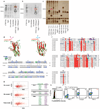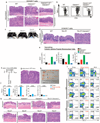CEACAM1 regulates TIM-3-mediated tolerance and exhaustion
- PMID: 25363763
- PMCID: PMC4297519
- DOI: 10.1038/nature13848
CEACAM1 regulates TIM-3-mediated tolerance and exhaustion
Erratum in
-
Corrigendum: CEACAM1 regulates TIM-3-mediated tolerance and exhaustion.Nature. 2016 Aug 18;536(7616):359. doi: 10.1038/nature17421. Epub 2016 Mar 16. Nature. 2016. PMID: 26982724 Free PMC article. No abstract available.
-
Author Correction: CEACAM1 regulates TIM-3-mediated tolerance and exhaustion.Nature. 2024 Feb;626(8001):E19. doi: 10.1038/s41586-024-07164-y. Nature. 2024. PMID: 38336833 No abstract available.
Abstract
T-cell immunoglobulin domain and mucin domain-3 (TIM-3, also known as HAVCR2) is an activation-induced inhibitory molecule involved in tolerance and shown to induce T-cell exhaustion in chronic viral infection and cancers. Under some conditions, TIM-3 expression has also been shown to be stimulatory. Considering that TIM-3, like cytotoxic T lymphocyte antigen 4 (CTLA-4) and programmed death 1 (PD-1), is being targeted for cancer immunotherapy, it is important to identify the circumstances under which TIM-3 can inhibit and activate T-cell responses. Here we show that TIM-3 is co-expressed and forms a heterodimer with carcinoembryonic antigen cell adhesion molecule 1 (CEACAM1), another well-known molecule expressed on activated T cells and involved in T-cell inhibition. Biochemical, biophysical and X-ray crystallography studies show that the membrane-distal immunoglobulin-variable (IgV)-like amino-terminal domain of each is crucial to these interactions. The presence of CEACAM1 endows TIM-3 with inhibitory function. CEACAM1 facilitates the maturation and cell surface expression of TIM-3 by forming a heterodimeric interaction in cis through the highly related membrane-distal N-terminal domains of each molecule. CEACAM1 and TIM-3 also bind in trans through their N-terminal domains. Both cis and trans interactions between CEACAM1 and TIM-3 determine the tolerance-inducing function of TIM-3. In a mouse adoptive transfer colitis model, CEACAM1-deficient T cells are hyper-inflammatory with reduced cell surface expression of TIM-3 and regulatory cytokines, and this is restored by T-cell-specific CEACAM1 expression. During chronic viral infection and in a tumour environment, CEACAM1 and TIM-3 mark exhausted T cells. Co-blockade of CEACAM1 and TIM-3 leads to enhancement of anti-tumour immune responses with improved elimination of tumours in mouse colorectal cancer models. Thus, CEACAM1 serves as a heterophilic ligand for TIM-3 that is required for its ability to mediate T-cell inhibition, and this interaction has a crucial role in regulating autoimmunity and anti-tumour immunity.
Figures











References
-
- Monney L, et al. Th1-specific cell surface protein Tim-3 regulates macrophage activation and severity of an autoimmune disease. Nature. 2002;415:536–541. - PubMed
-
- Sabatos CA, et al. Interaction of Tim-3 and Tim-3 ligand regulates T helper type 1 responses and induction of peripheral tolerance. Nature Immunol. 2003;4:1102–1110. - PubMed
-
- Sánchez-Fueyo A, et al. Tim-3 inhibits T helper type 1-mediated auto-and alloimmune responses and promotes immunological tolerance. Nature Immunol. 2003;4:1093–1101. - PubMed
Publication types
MeSH terms
Substances
Grants and funding
- R37 DK044319/DK/NIDDK NIH HHS/United States
- AI039671/AI/NIAID NIH HHS/United States
- R01 DK088199/DK/NIDDK NIH HHS/United States
- R01 DK051362/DK/NIDDK NIH HHS/United States
- P01 AI056299/AI/NIAID NIH HHS/United States
- DK0034854/DK/NIDDK NIH HHS/United States
- R01 DK053056/DK/NIDDK NIH HHS/United States
- R01 NS045937/NS/NINDS NIH HHS/United States
- R37 GM032415/GM/NIGMS NIH HHS/United States
- DK051362/DK/NIDDK NIH HHS/United States
- P01 AI039671/AI/NIAID NIH HHS/United States
- AI073748/AI/NIAID NIH HHS/United States
- P41 GM111244/GM/NIGMS NIH HHS/United States
- T32 GM007122/GM/NIGMS NIH HHS/United States
- GM32415/GM/NIGMS NIH HHS/United States
- DK044319/DK/NIDDK NIH HHS/United States
- P30 DK034854/DK/NIDDK NIH HHS/United States
- NS045937/NS/NINDS NIH HHS/United States
- R01 GM032415/GM/NIGMS NIH HHS/United States
- AI056299/AI/NIAID NIH HHS/United States
- UL1 TR001102/TR/NCATS NIH HHS/United States
- P01 AI073748/AI/NIAID NIH HHS/United States
- DK088199/DK/NIDDK NIH HHS/United States
- R01 DK044319/DK/NIDDK NIH HHS/United States
- R01 GM026788/GM/NIGMS NIH HHS/United States
- DK053056/DK/NIDDK NIH HHS/United States
- R56 DK053056/DK/NIDDK NIH HHS/United States
LinkOut - more resources
Full Text Sources
Other Literature Sources
Molecular Biology Databases
Research Materials
Miscellaneous

